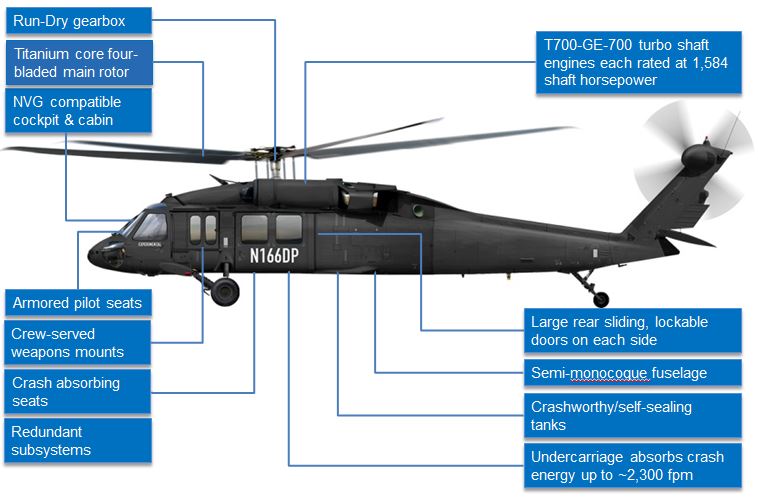Flying High: UH 60 Helicopter Safety Protocols You Need To Know
Flying High: UH 60 Helicopter Safety Protocols You Need To Know
Blog Article
Understanding the Mechanics and Design Behind Uh 60 Helicopters
The UH-60 helicopter, generally known as the Black Hawk, stands as a peak of modern-day rotorcraft modern technology, embodying a blend of durable design and detailed mechanics. As we peel back the layers of the UH-60's style, a globe of detailed systems and meticulous engineering comes to light.
History of UH-60 Helicopters
The history of UH-60 helicopters traces back to the late 1970s when the USA Military sought a versatile and advanced utility helicopter to change its aging fleet. In feedback to this requirement, the Sikorsky Aircraft Firm created the UH-60 Black Hawk helicopter. Introduced in 1979, the UH-60 quickly came to be a staple in army operations due to its remarkable capabilities.
The UH-60 was made to stand out in a variety of goals, including army transport, clinical emptying, electronic war, and special procedures. Its capability to adjust to different duties made it a useful asset to the united state Military and various other military forces around the world
Throughout the years, the UH-60 system has undertaken a number of upgrades and variants to enhance its efficiency and keep speed with evolving objective needs. These helicopters have seen extensive service in problems such as the Gulf War, Afghanistan, and Iraq, showcasing their dependability and convenience in diverse functional settings. The UH-60's rich history is a testimony to its long-lasting legacy as a leading energy helicopter.

Engine and Power Systems
Making use of innovative propulsion innovation, UH-60 helicopters are equipped with innovative engine and power systems to make sure optimal efficiency and dependability in an array of functional scenarios. The UH-60, typically known as the Black Hawk, is powered by 2 General Electric T700-GE-701D engines, each efficient in supplying up to 1,940 shaft horsepower. These turboshaft engines give the needed thrust for the helicopter to accomplish its missions successfully, including army transportation, medical discharge, and battle assistance.

Blades System and The Rules Of Aerodynamics
How do the blades system and aerodynamics of UH-60 helicopters add to their functional performance and trip abilities? The rotor system of the UH-60 helicopter plays an essential role in offering lift and propulsion. The UH-60 features a four-bladed, totally verbalized blades system that enables high maneuverability and security during trip. This design makes it possible for the helicopter to carry out a wide variety of missions, from transportation and medical discharge to deal with procedures.
Aerodynamics likewise play a vital function in the efficiency of UH-60 helicopters. The structured fuselage and rotor blade style lower drag, allowing the helicopter to accomplish greater rates and better fuel performance. The wind resistant design of the UH-60 likewise adds to its capacity to operate in diverse ecological problems, consisting of high elevations and hot temperatures.
Avionics and Flight Control Systems

In its elaborate coordination with the rotor system and aerodynamics of UH-60 helicopters, the avionics and flight control systems form a crucial network of technologies forming the aircraft's operational capacities. In the UH-60, these systems consist of digital display screens, interaction radios, GPS navigation, weather radar, and auto-pilot systems.
The flight control systems of the UH-60 are in charge of converting the pilot's inputs into the appropriate changes to the rotor system, guaranteeing secure trip and maneuverability. These systems contain hydraulic actuators, servos, and computers that collaborate to regulate the primary and tail blades, in addition to various other flight control surface areas. By exactly taking care of the helicopter's flight characteristics, these systems allow pilots to execute a variety of objectives, from transport and search-and-rescue to deal with procedures, with precision and self-confidence.
Role and Applications in Air Travel
Avionics systems in UH-60 helicopters encompass a range of digital systems that help in navigating, interaction, tracking, and controlling numerous airplane functions. These systems include digital display screens, auto-pilot systems, interaction radios, GPS navigation tools, and weather condition radar. Furthermore, these systems incorporate safety attributes such as autopilot modes, surface understanding cautioning systems, and stability enhancement systems to improve the overall safety and security and operational capabilities of the UH-60 helicopters in numerous objectives, including army transport, clinical discharge, search and rescue, and aerial firefighting.
Conclusion
In final thought, the UH-60 helicopter is a functional aircraft with an abundant history and progressed engineering. Its engine and power systems, rotor system, the rules of aerodynamics, avionics, and trip control systems all work together to make it a reliable and effective device.
In its detailed coordination with the rotor system and aerodynamics of UH-60 helicopters, the avionics and trip control systems create a vital network of modern technologies go to this web-site shaping the aircraft's click for info operational abilities.The trip control systems of the UH-60 are liable for converting the pilot's inputs into the appropriate modifications to the blades system, making certain stable flight and maneuverability. Avionics systems in UH-60 helicopters encompass a variety of electronic systems that aid in navigation, communication, tracking, and managing different aircraft functions. Furthermore, these systems integrate security functions such as autopilot modes, terrain awareness cautioning systems, and stability visit this web-site augmentation systems to boost the total safety and security and functional capacities of the UH-60 helicopters in numerous objectives, including troop transportation, clinical discharge, search and rescue, and aerial firefighting.
Its engine and power systems, rotor system, aerodynamics, avionics, and flight control systems all function with each other to make it a trustworthy and effective device.
Report this page